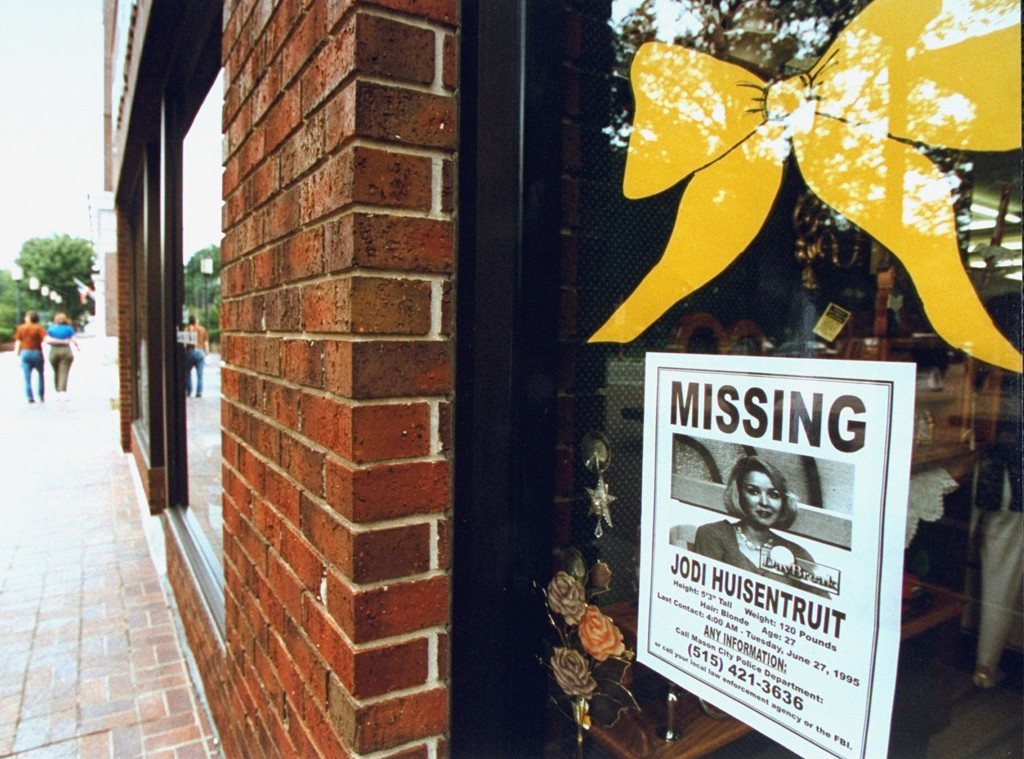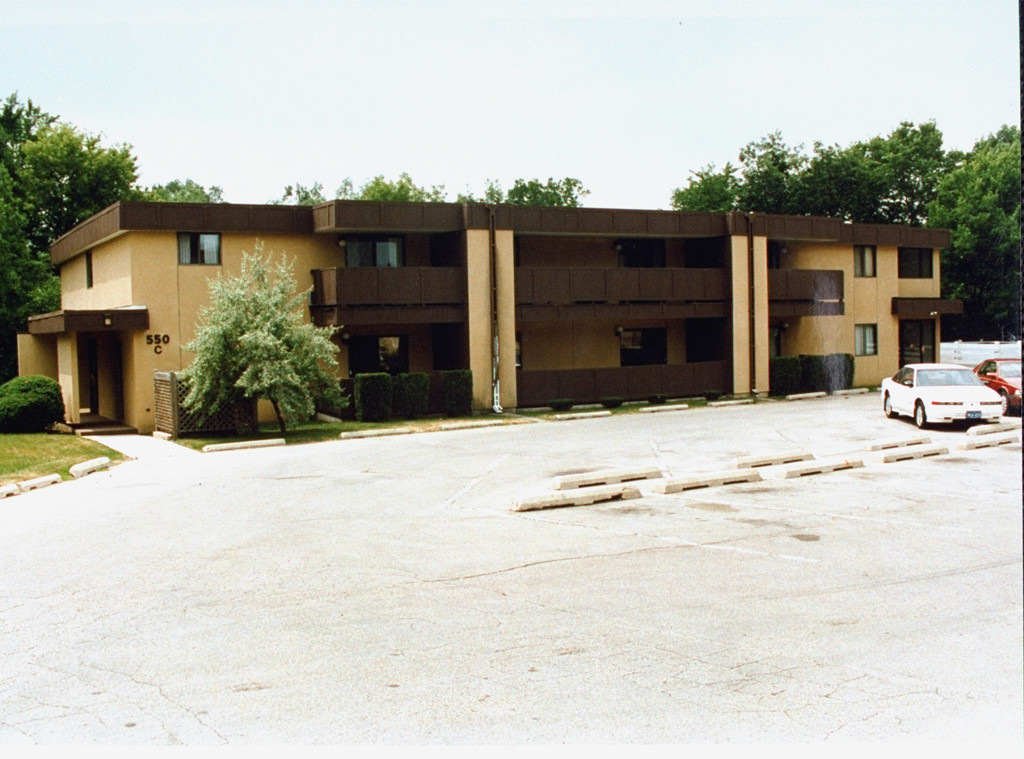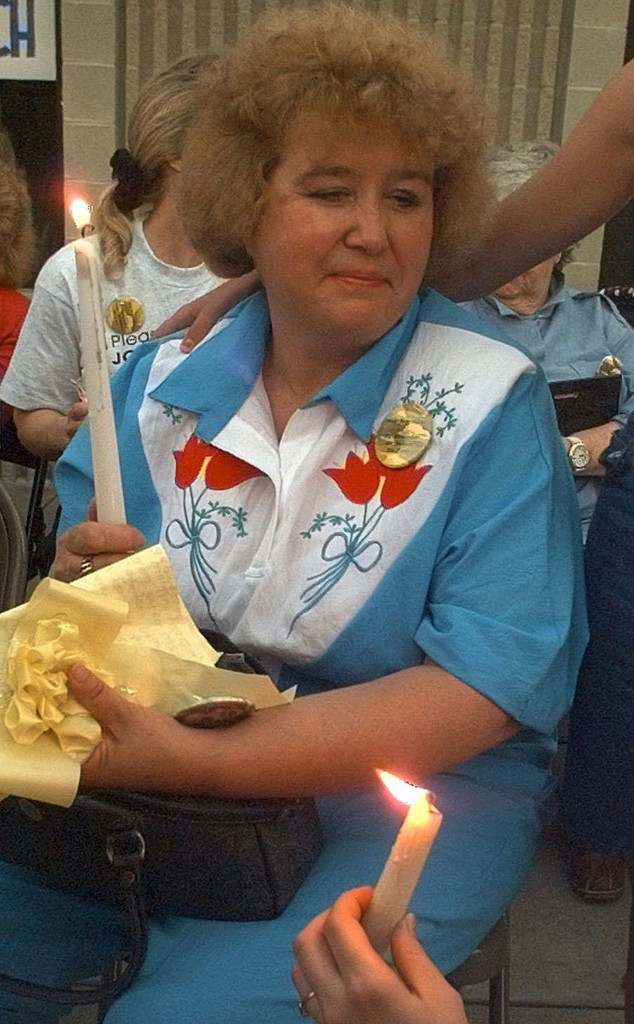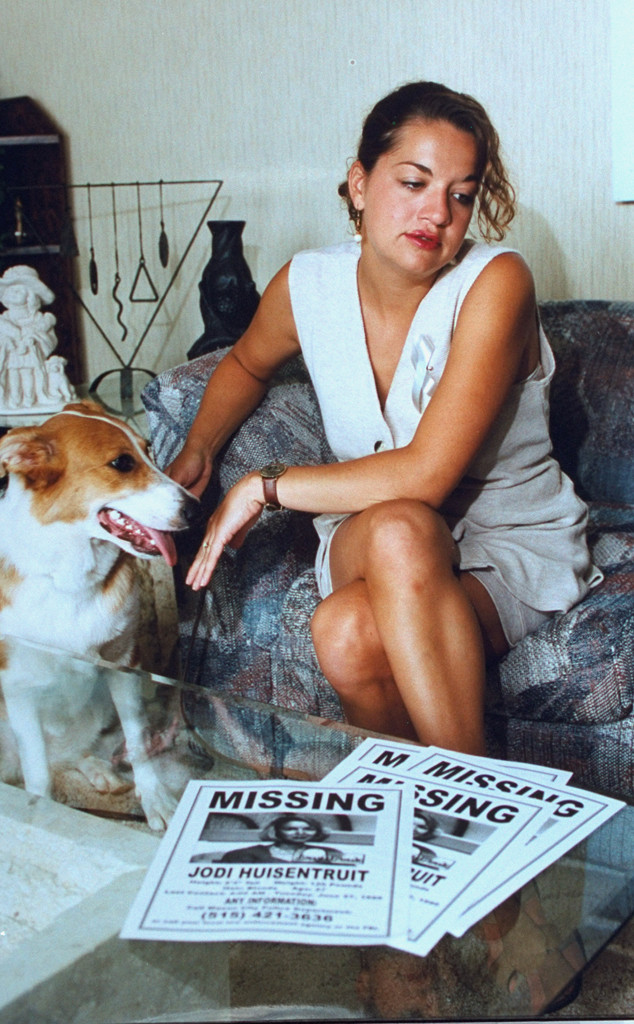
Steve Kagan/The LIFE Images Collection/Getty Images
Something happened to Jodi Huisentruit. Exactly what remains a mystery.
The 27-year-old from Long Prairie, Minn., had found her way to Mason City, Iowa, the latest of several stops she’d made on the traditional broadcast-journalist path from market to increasingly bigger market. She was a morning anchor at KIMT-TV, serving north central Iowa and southeastern Minnesota, and was up before dawn every day in time for DayBreak at 6 a.m. She aspired to go national one day.
“She wanted to be famous,” childhood friend Kim Feist told 48 Hours.
On June 27, 1995, DayBreak producer Amy Kuns called Huisentruit at home shortly after 4 a.m. to see why she wasn’t at work yet, as she was usually there closer to 3 a.m.
“I called her twice. I talked to her and woke her up that first time,” Kuns remembered in a 2011 interview with WFLA news anchor Josh Benson, who co-founded FindJodi.com with journalist Gary Peterson. “The second time, it just rang and rang. I don’t remember the times. I had obviously woken her up. She asked what time it was. I told her. She said she’d be right in.”
Kuns asked Benson to check the police report for the exact time she called, but if memory served it was 4:10 a.m. She was the last person known to have spoken to Huisentruit before she disappeared into thin air.
But she obviously didn’t disappear into thin air. And Benson, who used to work in Austin, Minn., is among the determined group—not including the countless armchair experts who have traded theories on FindJodi message boards, on Facebook or, inevitably, on Reddit over the years—that remains dedicated to finding answers to questions that grow colder every year.
Jodi was declared dead on May 14, 2001, but, to this day, no body or any other physical trace of her has ever been found.

Kyndell Harkness/Minneapolis Star Tribune via ZUMA Wire
“It really is a very sad story, it is really poignant,” 48 Hours correspondent Jim Axelrod told Inside Edition ahead of an episode that aired last weekend about the unsolved case. “This summer she would have turned 50 and you get that sense that, oh my goodness, she’s frozen forever at 27. What happened?”
FindJodi arranged for four billboards in Mason City to go up on June 5, what would’ve been her 50th birthday, sporting signs with Jodi’s picture and a message: “Somebody knows something… is it YOU?”
Another contributor to FindJodi is Caroline Lowe, who was on the crime beat for WCCO-TV in Minneapolis-St. Paul when Huisentruit vanished. Two years later she was reporting on an accused serial rapist when it turned out he lived two blocks away from KIMT —and Lowe’s interest was piqued.
“Once I met her sister and met her family you feel a connection that you can’t walk away from,” Lowe told NBC Bay Area in May 2017. “I just stayed with it over the years, did follow up stories.” She left WCCO in 2015 after 35 years to be the news manager at KSBY-TV in San Luis Obispo, Calif., but didn’t leave Jodi behind.
“Jodi was a Minnesota gal who had a dream of going to the Twin Cities someday where I worked,” Lowe said. “We very possibly would have worked together if things had taken a different turn.”
Among the journalists in the region who took the case to heart was Beth Bednar, a veteran reporter and anchor at KAAL-TV in southeast Minnesota when Huisentruit went missing. Gary Peterson of FindJodi.com was her news director.
“I couldn’t believe that anyone would go after a well-known, visible individual in the news business,” she told the Elk River Star News in 2012. Some years after Peterson first suggested she write a book about the case, she started on what would become Dead Air: The Disappearance of Jodi Huisentruit in 2009.
“No one wanted to talk about Jodi Huisentruit,” Bednar recalled. “I hit road block after road block and doors were even shut in my face.” Police wouldn’t talk and people she wanted to interview seemed scared for her, she claimed.
“I never expected there to be an atmosphere of denial and a culture of resistance to solving the murder of this young woman,” she said, “and after I encountered it, I was hooked—I knew I had to write this book and work on solving this case. There was just something unnatural about the situation that begged to be explained.”
Bednar insisted, “The people of Mason City know something—they know a whole lot more about what happened to Jodi Huisentruit than they are letting on.”
But that didn’t mean it wasn’t a city in mourning.
On the first anniversary of her disappearance, June 27, 1996, 27 yellow balloons were released over the municipal pool in Mason City, along with four white balloons that represented her and three other missing people. And on the 20-year anniversary in 2015 there was a walk—”Finishing Jodi’s Journey”—from Riverside Friends Church, near her apartment complex, to the KIMT office.

AP Photo/Rodney White
In 2015, Lowe and retired Woodbury, Minn., Police Cmdr. Jay Alberio met at Alberio’s house to compare notes on Tony Jackson, the serial rapist Lowe had been investigating all those years ago. Jackson was arrested in 1997, convicted of rape and burglary in 1999 and sentenced to life in prison as a repeat sex offender—but he had been a 21-year-old free man living in Mason City on June 27, 1995.
“We don’t know if he is involved,” Lowe told the St. Paul Pioneer Press. “We, to this day, don’t know, but if you think of a person living that close who is capable of very violent stuff, he had to be investigated.” She added, “Maybe there is something that eliminates him; we just don’t know what it is. We’re not locked into any one person. We’re there to keep digging. We’re going to continue her journey until we have answers.”
But Jackson remained on their mind. Alberio told 48 Hours this year, “He’s got rope, he’s got handcuffs, he’s got his gun, he’s got duct tape. Basically, it’s a rape kit…All the victims that we know of, there is an element of stalking.”
Footage of Lowe interviewing Jackson’s ex-girlfriend back in 1998 showed her saying they had broken up five days before Jodi disappeared. “And it was, it was violent, very violent,” she described his reaction. “I mean, it was a totally different person. It was like the devil stepped inside of him and just took over.”
Lowe also talked to a former jail mate of Jackson’s, who claimed Jackson had said he abducted an anchorwoman and killed her. Jackson even rapped about it and, reading from a piece of paper where he had jotted down what Jackson said, the ex-convict told Lowe, “He said ‘she’s a-stiffin’ around Tiffin in pileage of silage in a bylow, low below…'”
That was enough to prompt Lowe to alert law enforcement and head to Tiffin, which is about a 10-hour drive southeast of Mason City. Two of three cadaver dogs brought by law enforcement seemed to sense something near a farm silo, she recalled on 48 Hours.
The State Crime Lab analyzed some samples taken at the scene, but in 1999 the Mason City Police issued a statement reading, “After conducting a thorough investigation which included interviews, crime laboratory analysis, records review, and polygraph examination, Tony Jackson is not considered, at this time, a viable suspect in the investigation.”
Asked for an interview this year, Jackson refused but replied to 48 Hours in a lengthy email in which he stated, “I Stand firm in my Integrity regarding the Jodie [sic] Huisentruit case.”

Steve Kagan/The LIFE Images Collection/Getty Images
When Huisentruit still wasn’t at work by 5:30 a.m., Kuns called and got Jodi’s home answering machine (no cell phones in this case). At 6 a.m., Kuns still wasn’t particularly alarmed, assuming Jodi had gone back to sleep. At the worst, she thought, perhaps Jodi had fallen in the shower. She ended up filling in for her on Daybreak, an hour-long show.
At 7 a.m. someone at the station called police to request a welfare check on Huisentruit.
“Jodi had been really up and down before her disappearance,” Kuns said. “She would fall asleep in edit bays…and later in the day be really perky. I wondered what was going on with her. I would not be surprised if drugs were involved.”
Bednar theorized that Huisentruit’s abduction could have been drug-related, telling the Elk River Star, “1995 was a pretty busy time for drugs like marijuana, cocaine, and meth in small towns along Interstate 35, and there was a large-scale drug operation in Mason City at the time of Jodi’s disappearance.”
She said, “I think one of the reasons this case is so enduring is that it is a cautionary tale about an ordinary small-town woman who may have gotten in over her head with some very bad people. It also hit close to home in small-town America, and we know that there’s a murderer still out there, walking free, but those of us who remember Jodi won’t rest until this is solved.”
But while one of the threads on FindJodi.com is “Drug Activity at the Time of Jodi’s Abduction,” where they keep track of local news stories about drug-related crime, neither her friends, family nor law enforcement have mentioned that any time recently as a pertinent angle.
In 2015, talking to the Pioneer Press, Kuns remembered, “My first gut reaction was just to be mad. I’m like, ‘Where the hell is she?’…Never in a million years did I envision abduction.”
Those who were closest to her didn’t recall anything being off with her. The biggest problem, her sister JoAnn Nathe recalled to 48 Hours, was that Jodi was “definitely too trusting.” Even years before social media was around to share up-close-and-personal details and pictures with millions of strangers, Nathe worried that her sister was “revealing too much maybe, of what she did day-to-day” on the air.

Steve Kagan/The LIFE Images Collection/Getty Images
When police arrived at Jodi’s apartment complex, they found signs of a struggle in the parking lot, where her red Mazda Miata sat, still waiting for its owner to get in and speed off to work. A pair of red high heels, a hairdryer, earrings and a can of hairspray were on the ground, along with her car key—which was bent, as if it was in the lock and she hung tightly to it as someone tried to pull her away. A partial palm print that didn’t belong to her was found on the car. Neighbors remembered hearing a scream shortly after 4 a.m., and some recalled seeing a white van with its parking lights on in the lot.
No one called 911 or the police.
Eventually there would be questions about whether mistakes were made in processing the scene at the time, and in hindsight the answer was yes. For instance, a friend of Jodi’s who was interviewed said that police didn’t immediately tape off the scene around her car, which could have resulted in potential evidence being contaminated or overlooked. And the Miata was released back to Jodi’s parents after just a few months.
Asked if he thought the car was released too hastily, Mason City Police Chief John Brinkley, the fourth police chief to have the case under his command, told 48 Hours, simply, “Maybe.”
“We don’t have it,” Brinkely said. “But we just have to live with what we got, and—and try to do as good as we can with that.”
But the ensuing search was extensive as K-9 units combed the area, including the banks of the Winnebago River, and Jodi’s disappearance became the lead story on her own station. Ultimately, state investigators and the FBI would get involved.
Meanwhile, police descended on the newsroom, looking for evidence of a stalker or any enemies or angry viewers. And in fact, Jodi had gone to police in October 1994 to report a black truck following her while she was out for a jog. Nothing ever came of it and she never reported another incident.

AP Photo/Rodney White
“I just pray that whoever has her out there, if they’ll just, you know, she’s so sweet and good,” JoAnn Nathe pleaded into the cameras in 1995. “She’d never hurt anyone. Just let her go.”
On June 30 the case escalated from missing person to an abduction and the fire department honed in on the river.
Meanwhile, yellow ribbons sprang up all over town as residents rallied for the search, making T-shirts, bumper stickers and missing-person posters.
“People here have a real connection with the local media,” Lt. Rich Jensen told the Pioneer Press. “They would turn on the news, in the morning or at noon, and there she was. They didn’t know her personally, but they knew her.”
As police and Jodi’s family sought any bit of information, the story became national news. The case, naturally, was also ideal fodder for the what-happened-to-the-young-photogenic-white-woman lead story that never fails to intrigue the masses. Yet for the family, friends, law enforcement and journalists who have never given up on finding out the truth, that widespread attention was the best chance they had to crack the case.
“If you’re a kidnapper, there are a lot of possibilities that you should have gotten caught,” Mason City Police Officer Terrance Prochaska, who took over the case in 2010, told WOWT-TV’s Brian Mastre, who anchored the evening news at KIMT when Jodi was there. “In an apartment complex, there are a lot of windows facing out…what a risky place to abduct someone. So you think maybe it was someone who knew her? There again—what if it was someone who was lurking around apartments looking for prey?”
They still cross-referenced Jane Doe remains against everything they have in the system for Jodi, he explained to the Omaha, Neb., station in 2015. And a few tips still came in every month.
“These are some recent ones where I got some follow-up done,” Prochaska said. “Many cops don’t know this—but there are a lot of female unclaimed Jane Does out there in the network—whether they were body parts or simply DNA—so we try to compare what we have to all of those. Obviously we have Jodi Huisentruit’s information. We have her DNA, her fingerprints and her dental records. We have the sources here to rule out these types of leads and we get a significant amount of them.”
“Basically, all my free time is following up on this case,” he continued. “What caused her to sleep in that day? What caused her to answer the phone and rush into work? What was she doing the night before? We all want to know the fine details. We know where she was at. She was golfing. She had driven home and made a phone call to her friend. Those are facts. But it’s that gray area in between that we don’t understand.”
“We expect that with the 20th anniversary, we will get more,” Mason City Police Lt. Rich Jensen told the Pioneer Press. “It’s like any anniversary—it stirs people’s emotions. We’re waiting for the call. We’re hoping that there will be a day we’re in the courtroom, and somebody will be held accountable.”

Steve Kagan/The LIFE Images Collection/Getty Images
“I couldn’t have had a better kid sister,” JoAnn Nathe told the Omaha-based WOWT. “She tried to motivate me. What are your goals? That makes me stronger. It’s a nightmare…not knowing where she is. We were hoping to find her in the first few months.” Their mother, Imogene, died in December 2014 at 91. “She so wanted to find Jodi,” Nathe said.
Jodi’s family let a local station film inside her apartment that September. There were no obvious signs of a struggle. There were dishes in the sink, an empty Pepsi can lay on its side on the kitchen table amid piles of work papers and an unset clock flashed 12:00 on the VCR. Her answering machine showed a new message forever unheard.
“I still remember all of the cards they found in Jodi’s apartment. They were birthday cards. I think there were 50 of them and we’re reading through them,” Doug Jasa, a private investigator who had a license to practice in Iowa and was therefore hired by a Minnesota P.I. employed by Jodi’s family, told KWOWT. “People had written very nice notes in the birthday cards.”
After work on Monday, June, 26, she played in a Chamber of Commerce golf tournament, where, according to witnesses, she mentioned she’d been getting some crank phone calls and was thinking of changing her number or going to police. She spent part of that evening at the home of her friend John Vansice, who was 22 years older than Jodi and is the last known person to see her. They were watching video he had shot at a surprise party he had thrown for Jodi’s birthday earlier that month, he said. They had also just gone water-skiing with some other friends that last weekend; Vansice had a boat he had named Jodi.
“She was like a daughter to me, she was just like my own child,” he said in an interview with KIMT back in 1995. “I treated her like my own child.”
Vansice, who passed a lie detector test early on and was never named as a suspect, denied knowing anything about what ultimately happened to Jodi, though that didn’t stop the gossip from raging; he eventually left the area and moved to Arizona, where he currently still lives. (The now-72-year-old Vansice refused to comment when 48 Hours‘ Axelrod knocked on his door.)
Back in 1995, however, Vansice did talk to 48 Hours—down by the dock, where he kept his boat—when the CBS show covered the investigation in Mason City, and he said he believed Jodi was “alive somewhere. I just hope she’s not hurt. I hope she’s OK and I hope she can come back soon.”
He also said, “She wouldn’t want us to sit around home and cry and sob; she’d want us to be out having fun ’cause that was her.” “Is her,” added their friend Ani Kruse. “It is her,” Vansice corrected himself.
John Skipper, a recently retired local newspaperman, recalled in a column for Mason City’s Globe Gazette in October talking to Vansice on June 30, 1995, while waiting for then-Chief of Police Jack Schlieper to come out and give an update on the case. Vansice didn’t seem as shaken up as a man reeling from the disappearance of a woman he thought of like a daughter might be, Skipper remembered. The 49-year-old Vansice volunteered that he had just passed a polygraph and he and some friends were planning a “kegger” that night to celebrate.
When Schlieper found out Vansice had talked to him, Skipper wrote, the police chief told him, “Anyone who truly cares about Jodi’s safety would not want to jeopardize that safety or our investigation by talking to the media about their involvement in our investigation.”
Ani Kruse explained to 48 Hours 23 years ago that she and Huisentruit first met Vansice, a recent divorcé, out at a bar one night. He happened to have previously lived in Jodi’s apartment complex. Kruse co-hosted the surprise birthday party for Jodi, complete with a waterskiing-themed cake, at John’s house.
“There’s no possibility in my mind that [Vansice] could ever” have hurt Jodi, Kruse said at the time.
The idea became more possible to her over the years, however, though she told 48 Hours in 2018 that she still didn’t understand why he would have picked that morning, in the parking lot, to do something. But maybe, she thought, he finally made an advance and it went wrong.
A friend of Vansice’s named LaDonna Woodford insists to 48 Hours that he was being unfairly targeted then and now—and that she called him at 6 a.m. that morning about going for a walk, which they regularly did, and it sounded as if he had been sleeping. (Again, no cell phones, so she knew he was home.) They went walking and he didn’t seem anxious or otherwise unlike himself.
Though that was almost two hours after Amy Kuns last talked to Jodi on the phone, Woodford is confident that it was “almost impossible” for Vansice to have done anything nefarious.
In March 2017, a search warrant were issued for the GPS on two vehicles linked to Vansice, a 1999 Honda Civic and 2013 GMC 1500—the most significant development in the case in decades. However, nothing of import was recovered, Brinkley said. He did confirm to FindJodi.com that the warrant was part of the ongoing investigation, saying “we continue to actively work” on the case.
Brinkley reiterated on 48 Hours, “We have never closed the case. It’s never been a closed case for us. It’s been an active investigation since it happened.”
He added, “I’m not ready to quit yet.”
That being said, there are still no suspects or official persons of interest.
“I feel as ignorant as the next person. I just don’t know,” Doug Merbach, the news director at KIMT in 1995 and the one who hired Jodi, told Omaha’s WOWT-TV in 2015. “I don’t want to point fingers at anybody without looking inside the investigation and opening up those books. I don’t know. I think it had to be somebody who knew her. I think it had to be somebody who had an emotional response to something Jodi said or did that caused them to do that. I don’t think it was random—I don’t think it was planned. I think it was planned to a certain extent—but not days and weeks ahead of time.”
Merbach also said, “They use that word closure a lot. For Jodi’s family, I don’t think there’s any such thing after having a wound fester for 20-years—how do you close that up immediately? Where I work in Mason City now—from my office—I can see the tree that we planted for Jodi. It’s a reminder for me every day of what happened 20 years ago. It’s still very close. It’s still very fresh.”
“Makes me sad to be right here for some reason. Sad, and then peaceful too,” Robin Wolfram, who anchored the evening news at KIMT—including the broadcast first reporting on Jodi’s disappearance—and was Jodi’s closest friend at the station, said on 48 Hours as she toured the newsroom with Axelrod and Merbach. Outside the station is a stone marker engraved with a golf ball and a TV camera.
Thinking of Jodi, “I think the first word that always comes to my mind is effervescent,” Wolfram said. “And people would often describe her as bubbly.”
“Kind of a bright light in the morning to get people started for the day,” Merbach added.
Wolfram, meanwhile, had interviewed Vansice for KIMT back in 1995 and felt that he had unrequited “strong and deep feelings” for Huisentruit. The fact that he named his boat after her, “I remember holding on to the microphone and just feeling so ill at ease and thinking to myself, ‘I think he might’ve done it.'” She left the station a few months after Jodi disappeared.
JoAnn Nathe, Jodi’s sister, also told 48 Hours this year that she had her suspicions about John, but “we have to be objective, we have to have an open mind. It could be somebody we least expect.”
